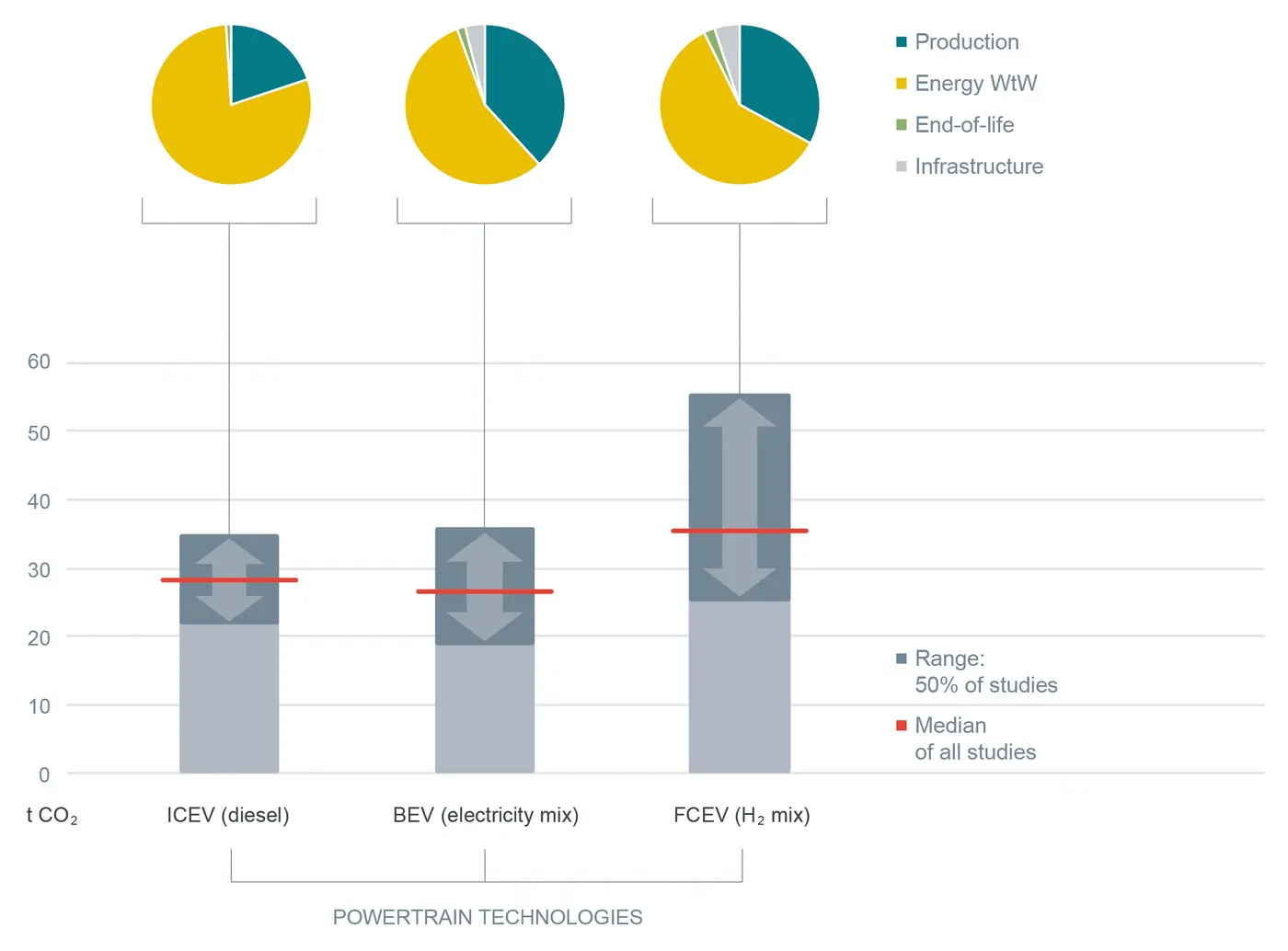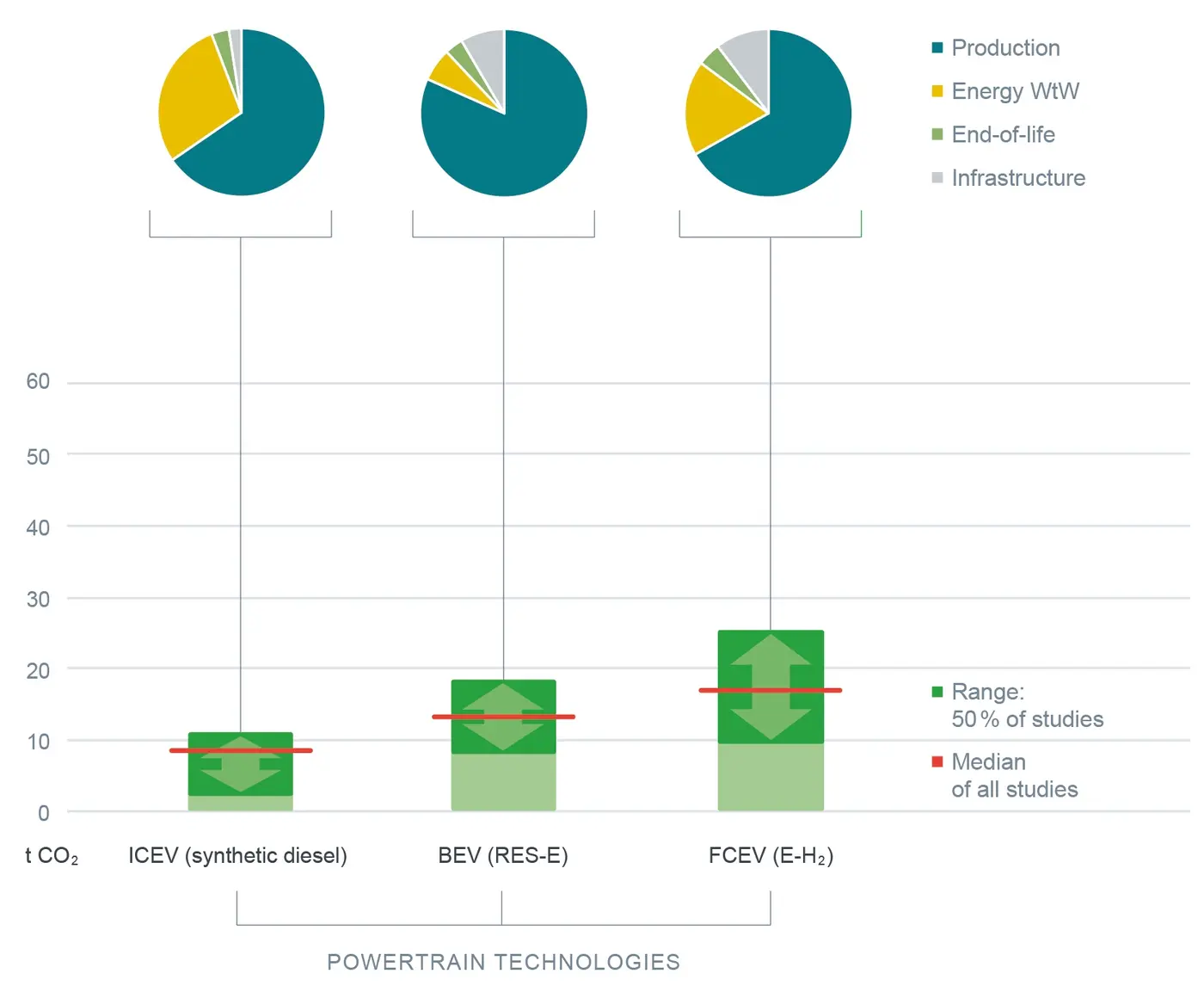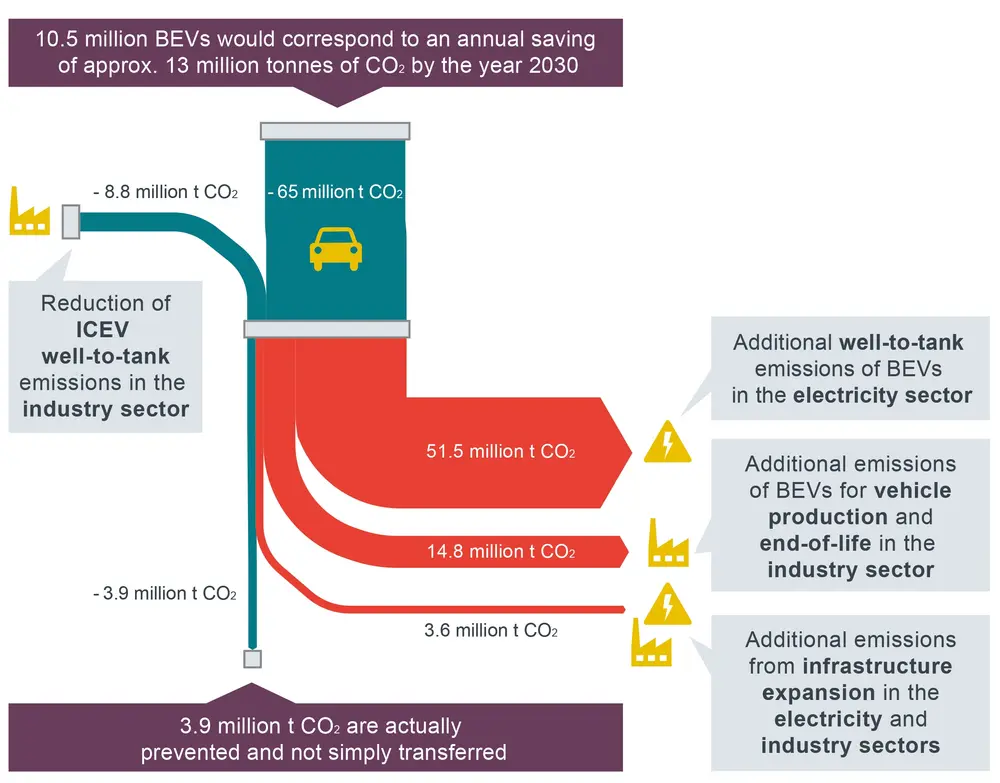Taking stock
Life cycle analyses (LCA) provide information on how climate-friendly new powertrain technologies really are. A new meta-analysis by the FVV Research Association for Internal Combustion Engines, conducted by Frontier Economics, analyses existing life cycle studies from the last 15 years. A supplementary paper derives central recommendations for drafting future climate protection regulations and guidelines: they should be economically efficient, cross-sectoral, open to technologies, global and long term in nature.
The study shows that in a global energy and carbon system, various technology options are available from a climate perspective. There is not one single solution for CO2 neutrality in the mobility sector. The key to sustainable mobility lies in fair technology competition and the defossilisation of energy production.
Contents
- Section 1 CO2 targets must consider the entire life cycle
- Section 2 Life cycle emissions
- Section 3 There is no clear winning technology
- Section 4 The mobility of the future requires diversity: The intelligent mix of alternative powertrains and fuels is what counts
- Section 5 Research must be technology-neutral, too
CO2 targets must consider the entire life cycle
Electric vehicles (BEV), hydrogen fuel cells (FCEV) and the use of synthetic fuels in internal combustion engines (ICEV): Various technologies and fuels are currently being discussed in order to significantly reduce harmful CO2 emissions from road transport. From a scientific point of view, not only the direct emissions during operation must be taken into account, but also those greenhouse gases that are emitted during the production of the vehicles, the generation of the energy sources/fuels, their distribution and, last but not least, recycling at the end of the vehicle's life. The method of life cycle assessment, usually abbreviated as LCA, has established itself as a means of producing a conclusive overall balance sheet. One challenge here is that the results of LCA studies depend heavily on the assumptions made.
In a meta-analysis, the specialist consultancy Frontier Economics on behalf of the FVV has now evaluated for the first time more than 80 individual studies from the past 15 years, which consider a total of 110 different scenarios and 430 individual analyses. In order to ensure comparability, the results of all studies were standardised to a compact passenger car with a total mileage of 150,000 kilometres.
CONCLUSION
Calculated in this way, there is a relatively narrow band of total emissions over the lifetime of all combinations of powertrains and energy sources/alternative fuels. The average value over all studies ranges from 25 to 35 tonnes of CO2 per vehicle, provided that fossil fuels are still used proportionately for the production of electricity, hydrogen or synthetic fuels. If, on the other hand, only regeneratively produced energy sources are used in operation, the average value is between 9 and 16 tonnes of CO2 for the entire service life of the vehicle. The remaining emissions then result mainly from the production of the vehicles, the production facilities and the infrastructure for the distribution of the energy sources.
Dr. David Bothe
Associate Director at Frontier Economics with over 15 years of experience in the energy and transport sectors. Co-founder of Frontier’s automotive expert-group. Advises European companies, associations and authorities on economic, regulatory, strategic and competition topics.
Has recently been working intensively on the impact of the green energy transition and climate targets on the energy and mobility markets – including on how to achieve the German climate targets and how this will change the economic evironment for individual mobility.
Has led various projects on possible technology options for sector coupling, including the use of hydrogen and CO2-neutral gases in the heating and transport sector or the import of synthetic fuels obtained through Power-to-X technologies.
Joined Frontier Economics in 2009. Prior to that, worked as a researcher and consultant at the Institute of Energy Economics (EWI) in Cologne. Lectured on energy and environmental economics and holds a PhD in Economics from the University of Cologne.
Theresa Steinfort
Consultant at Frontier Economics. Advises on strategic, regulatory and policy issues in the energy and transport sectors. Has recently focussed on life-cycle analyses, integration of renewable energies and sector coupling technologies and climate protection tools.
Joined Frontier Economics in 2015. Holds a MSc in Economics from Mannheim University and a BSc in International Economics from Maastricht University.
Frontier Economics Limited is a specialist economics consultancy that uses economic principles and tools to provide practical solutions to complex problems. Frontier was founded in 1999 and, now with over 250 permanent consulting staff in London, Berlin, Brussels, Cologne, Dublin, Madrid and Paris, is one of the largest specialist economic consulting firms in Europe and works for many of the major companies and most important policymakers around the world.
Frontier is an independent company, entirely owned by its employees.
Life cycle emissions
-

Life cycle emissions from current energy sources
If cars are powered by fossil fuels, with electricity from the current energy mix or with conventionally generated hydrogen, battery electric vehicles and internal combustion engine vehicles have comparable life cycle emissions.
-

Life cycle emissions when using 100% renewable energy for operation
If only renewable energy carriers are used during operation, a vehicle powered by synthetic fuels may even have lower CO2 emissions than a battery electric vehicle. There is still room for optimisation of the fuel cell.
Eine Lebenszyklusanalyse (englisch: Life-Cycle Assessment, LCA) berücksichtigt alle Umweltwirkungen während des Produktlebenszyklus. Dazu gehören insbesondere die Produktion einschließlich Materialen und Zulieferteilen, die Nutzungsphase sowie Entsorgung und Wiederverwertung. Bei einer Beschränkung auf einen bestimmten Abschnitt des Lebenszyklus, wie z. B. die Nutzungsphase eines Fahrzeugs, kann es dazu kommen, dass auch Technologien eine gute Bilanz aufweisen, die in einer Gesamtbetrachtung keine Emissionseinsparungen bewirken. Darum führt kein Weg an einer umfassenden Analyse vorbei, die alle Emissionen über den gesamten Lebenszyklus einer Technologie erfasst.
Neben
- der reinen Nutzung eines Fahrzeugs (Tank-to-Wheel)
gehören hierzu insbesondere
- die Herstellung eines Fahrzeugs (Cradle-to-Gate)
- die Erzeugung und Bereitstellung der Antriebsenergie (Well-to-Tank)
- der Aufbau und Betrieb der benötigten Verkehrsnetze (Straßen, Schienen- und Wasserwege) und Ver- und Entsorgungseinrichtungen (Infrastruktur)
- das Recycling zur Rohstoffrückgewinnung (End-of-Life).
Das CO2-Gesamtbudget des Weltklimarats IPCC (Intergovernmental Panel on Climate Change), auch Kohlenstoff- oder Emissionsbudget, bezeichnet die Menge der CO2-Emissionen aus anthropogenen Quellen, die seit Beginn der Industrialisierung freigesetzt wurde bzw. noch freigesetzt werden kann, um mit einer bestimmten Wahrscheinlichkeit eine globale Erwärmung über eine definierte Grenze hinaus zu vermeiden.
Das CO2-Budget im Sinn einer Restmenge noch emittierbarer Emissionen umfasst die kumulierte Gesamtmenge aller weltweit emittierten Treibhausgase. Für einen wirksamen Klimaschutz muss die kumulierte Menge an ausgestoßenen Treibhausgasen limitiert werden. Um dies zu erreichen, muss die gesamte Energiewirtschaft vollständig dekarbonisiert werden (geschlossener Kohlenstoffkreislauf mit Netto-Nullemissionen). Entscheidend für das Ausmaß des Klimawandels ist also nicht der gegenwärtige Ausstoß an Treibhausgasen, wie oft fälschlich angenommen wird, sondern die Gesamtmenge an Emissionen, die über die Zeit anfällt.
Auf der Grundlage des Pariser Klimaschutzabkommens haben sich Deutschland und die Europäische Union das ehrgeizige Ziel gesetzt, die Treibhausgasemissionen (CO2-Aq, CO2) bis 2050 um 80-95 % gegenüber 1990 zu reduzieren. Dementsprechend sieht der Klimaschutzplan 2050 der Bundesregierung ein Zwischenziel für 2030 vor. Bis dahin sollen die CO2-Emissionen mindestens 55 % unter dem Niveau von 1990 liegen. Dieses Ziel wurde in Einzelziele für die Sektoren Energie, Gebäude, Verkehr, Industrie, Land- und Forstwirtschaft sowie Landnutzung aufgeschlüsselt.
FAZIT:
- Alle Maßnahmen, die getroffen werden, um die CO2-Emissionen der einzelnen Sektoren zu reduzieren, müssen sich daran orientieren, wie wirksam sie für einen effizienten Einsatz des CO2-Restbudgets sind.
- Um Technologien im Hinblick auf Klima- und Nachhaltigkeitsaspekte sinnvoll bewerten zu können, müssen alle direkten und indirekten Auswirkungen aus allen vor- und nachgelagerten Stufen der Wertschöpfungskette berücksichtigt werden.
- Für eine nachhaltige Technologieauswahl braucht es eine umfassende branchenübergreifende, globale und intertemporale Lebenszyklusanalyse.
There is no clear winning technology
"There is no clear winning technology," summarises Dr David Bothe, Associate Director at Frontier Economics and author of the study.
For example, in none of the studies the GHG emissions resulting from the installation of the energy infrastructure were calculated down to individual vehicles. In addition, there are fewer than average results available on the influence of recycling - which can certainly improve the CO2 emissions of battery production, for example - and the results, moreover, scatter widely. While vehicles with battery electric drives or conventional internal combustion engines were considered in almost all studies, only a quarter of all studies make statements on the overall balance of plug-in hybrid vehicles, which are expected to achieve a significant market share in the 2020s. Fuel cell passenger cars are also only included in 22 studies. Valid results for the use of synthetic fuels are almost completely missing.
"In addition, no one has yet investigated where mobility today, despite its harmful impact, may also contribute to climate protection," says Bothe. "For example, the rotor blades of a wind power plant are transported to their location by heavy-duty fossil-fuelled commercial vehicles across the country. In the electricity sector, these plants then avoid emissions. We find such cross-sectoral effects in many places in the economy“.
CONCLUSION
Despite the considerable uncertainties, a general statement can be made: Only a valid life-cycle analysis allows an objective assessment of technological options. All technology options that provide comparable CO2 benefits should be equally supported and promoted.
The mobility of the future requires diversity: The intelligent mix of alternative powertrains and fuels is what counts
In particular, it is important to avoid that the emissions from operations allocated to the transport sector are reduced by allocating additional emissions to the energy or industrial sector. Using a sample calculation, the study points out that if electric mobility were to be introduced on a broad scale without accompanying measures, 90 percent of the cumulative CO2 savings from individual mobility could reappear in other sectors and regions by 2030, and would therefore be of little benefit to climate protection.
Impact of electric vehicles on the cross-sector CO2 residual budget
The goal is clear: By 2050, road transport is to become climate-neutral. When determining which paths to follow to achieve this goal, one should also bear in mind the time dimension of one-off events, such as a narrow focus on a sector-specific annual target: Large one-off emissions could lead to an increase in emissions in other years and/or sectors and the total CO2 budget calculated by the Intergovernmental Panel on Climate Change (IPCC) could be exceeded.
Research must be technology-neutral, too
FVV Managing Director Dietmar Goericke sums up: "From an academic point of view, the results of the study first of all simply mean: We need more data and more detailed research as a basis for valid political decisions. To do this, we need to keep research open to any new technologies." Carbon-neutral as well as near zero emission mobility and energy conversion are priority topics of the pre-competitive industrial collective research in the FVV.
Technology neutrality is essential for a cost-efficient and effective use of current technology options. This is the conclusion reached in the second short report of the Working Group 2 on A alternative drive / powertrain technologies and fuels for sustainable mobility of the National Platform »Future of Mobility« (NPM), which was presented in Berlin on 8 June. The main focus of the investigations of WG 2, which is co-chaired by Prof Dr Peter Gutzmer, President of the FVV, was the comprehensive evaluation of the CO2 effect of electric mobility concepts, hydrogen and fuel cells, as well as biomass- and electricity-based fuels for climate protection under the current framework conditions. Used appropriately, these technological options could specifically contribute to CO2 reduction. The prerequisites for carbon-neutral mobility are openness in technology and the accelerated expansion of renewable energies in Germany.
1 | Research Association for Combustion Engines (FVV): Efficient use of the global CO2 budget in the mobility sector - Four theories based on a meta-study on life-cycle analyses (Executive Summary | Briefing Paper). Frankfurt/M., 2020
2 | Research Association for Combustion Engines (FVV): Cradle-to-Grave Life-Cycle Assessment in the Mobility Sector - A Meta-Analysis of LCA Studies on Alternative Powertrain Technologies (Full Version | Expert Paper). Issue R595 | Frankfurt/M., 2020
3 | Frontier Economics / IfW: Carbon-neutral mobility powered by green electricity? How the power sector reacts to alternative mobility solutions. An assessment of energetic and regulatory effects on the CO2 emissions of alternative powertrain technologies and energy sources (Follow-up Study). Issue R598 | Frankfurt/M., Cologne, Kiel, 2021
Climate protection in the mobility sector needs a sustainable approach. This is the conclusion from a new meta-analysis on cradle-to-grave life-cycle assessments on alternative powertrain technologies jointly performed by FVV and Frontier Economics. In order to make a good choice among available technological alternatives, it is essential to provide policy makers, industry and consumers with robust and reliable data material. For this new analysis more than 80 studies from the last 15 years have been identified and reviewed that examine the life-cycle CO2 impact of vehicles and powertrains. From a climate perspective, no single technology came out on top. Zero-impact emissions and climate neutrality by 2050 require a technology-open, cross-sectoral, global and intertemporal approach.
4 | Research Association for Combustion Engines (FVV): Energy paths for road transport in the future: Options for climate-neutral mobility in 2050 (Executive Summary | Information Paper). Frankfurt/M., 2018
5 | Research Association for Combustion Engines (FVV): Defossilizing the transportation sector - Options and requirements for Germany (Full Version | Expert Paper). Issue R586, Frankfurt am Main, 2018
Road traffic is to be virtually climate-neutral by 2050. However, this goal can only be achieved if renewable energies are used in the transport sector. A working group at the Research Association for Combustion Engines (FVV) has therefore analyzed various energy paths. The resulting study examines the use of electricity, hydrogen and synthetic e-fuels as energy sources in road transport, taking both technical and economic factors into consideration.
Further studies on zero-impact emissions and alternative fuels as well as on openness in technology by society are currently in progress.
Further information
DETAILED RESULTS
- Efficient use of the global CO2 budget in the mobility sector - Four theories based on a meta-study on life-cycle analyses (Briefing paper)
- Cradle-to-Grave Life-Cycle Assessment in the Mobility Sector - A Meta-Analysis of LCA Studies on Alternative Powertrain Technologies (Study report)
- Carbon-neutral mobility powered by green electricity? How the power sector reacts to alternative mobility solutions (Follow-up study)
- Further studies of the FVV
RECOMMENDED ARTICLES
DOWNLOADS
- Download the article
- Presentation of the study at the FVV 2020 Autumn Conference | Dr David Bothe (video | DE | mp4)
- Press release | FVV (21/07/2020)
- We have to consider the return on investment | MTZ worldwide Cover Story (07-08/2020)
- IPCC | 1,5 °C Globale Erwärmung - Zusammenfassung für politische Entscheidungsträger (2018 | pdf)
- NPM | AG2 Einsatzmöglichkeiten unter realen Rahmenbedingungen (2020 | DE)
- NPM | AG2 Pressemitteilung (08.06.2020 | DE)

